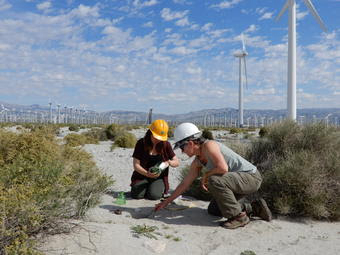Editor’s Note: The following feature was written by the Department of the Interior’s United States Geological Survey (USGS). Unlike the renaming of Volkswagen to Voltswagen, this is not an April fool joke.

Scientists collect carcasses at a wind energy facility to estimate total wildlife mortality at a site. (Public domain.)
|
CORVALLIS, OR – Reduction in wildlife mortality rates is sometimes cited as a potential benefit to the replacement of older, smaller turbines by larger, next generation turbines. In contrast, others have expressed concern that newer, larger turbines may actually increase bird and bat deaths.
A new USGS-led study suggests that the relative amount of energy produced by turbines in a given location, rather than simply their size, determines the rate of wildlife deaths. The study was published in the Journal of Applied Ecology on March 31.
Repowering is the replacement of smaller and tightly spaced turbines that each have a lower power capacity with fewer, larger, higher power-capacity turbines installed farther apart to generate similar or greater electrical energy output within the same area.

Dog-handler teams with high detection rates searched for carcasses to provide estimates of total wildlife mortality at a site. (Courtesy of Rogue Detection Teams)
|
As capacity, size and the number of turbines have grown globally, so has the need for reliable information regarding bird and bat fatalities caused by collision with rotating turbine blades, as well as ways to lessen such adverse impacts on wildlife. In this and other research, USGS scientists are studying the effects of energy infrastructure on wildlife and are working to develop technical and management options that can reduce risks to wildlife.
“Facility and turbine location, as well as the amount of energy production, are likely stronger determinants of wildlife deaths than the size of turbines installed,” said Manuela Huso, a USGS research statistician and the lead author of the report. “Our study indicates that simply replacing older and smaller wind turbines with newer and larger machines generating the same amount of energy has little effect on the rate of wildlife mortality. Additional, carefully designed studies are needed, however, to confirm these results.”